monish
AH elite
The Great Tuskers of the Kruger National Park , The Magnificent SEVEN
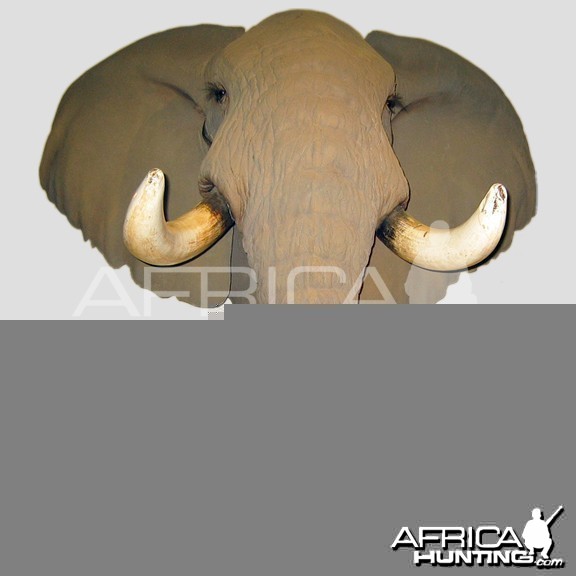
Elephant Head Mount at Letaba Elephant Hall, Kruger National Park
Letaba Elephant Hall at Kruger National Park is home of the Magnificent Seven. Over thirty years ago seven impressive elephant bulls, all with tusks weighing more than 50 kg each, could be found in Kruger National Park. The Chief Warden at the time, Dr. U de V Pienaar, decided to publicise these elephants as a successful example of Kruger's conservation work. He named those bulls that had not already been identified and also coined the collective name, the Magnificent Seven, based on the 1960 Hollywood film.
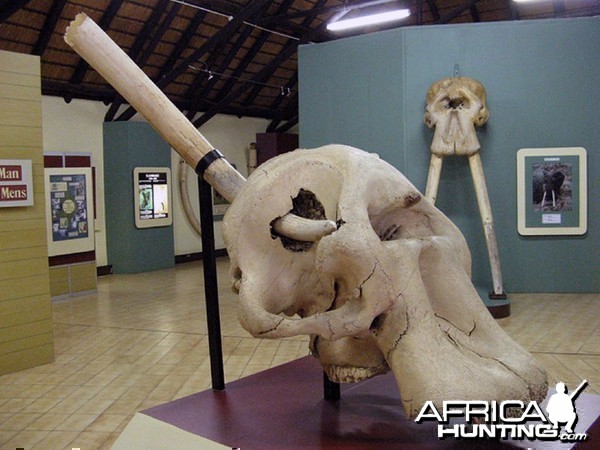
The Letaba Elephant Hall at Kruger National Park, South Africa displays most of the Magnificent Seven skulls, the great tuskers of Kruger. The skull in the foreground was found in the park as is, with a tusk embedded in it.
The promotion was launched in 1980 with specially commissioned paintings by celebrated wildlife artist Paul Bosman and illustrated articles written by the park's Senior Research Officer, Dr. Anthony Hall-Martin.
The public reaction was staggering and, when each of these great elephants died, it was decided to retrieve their tusks and skulls in order to display them. The Elephant Hall at Letaba Rest Camp now holds the tusks of Dzombo, Kambaku, Mafunyane, Ndlulamithi, Shawu and Shingwedzi.
The age of each of these elephants was estimated. Many marvellous stories are told about the size of these great mammals growing up to a height of 12 feet (nearly 3.7 meters) with a mass of 13,000 lb (6.000 kg) and tusks weighing in excess of 200 lb (91 kg) and reaching a length of 11 feet ( 3.35 meters).
The largest set of tusks currently available are a pair kept in the British Museum of Natural History weighing 226.25 lb and 214 lb a side, originating from the Legamishura crater. Another pair in the American Museum of Natural history weighing 189 lb and 178 lb a side originating from Kenya. Another pair came from an Elephant shot by the hunter: Maj. Powell-Cotton near Lake Albert in Uganda in the 1880’s, weighing 198 lb and 174 lb a side. A pair weighing 192 lb and 189 lb a side was shot in Tanzania in 1971. The hunter Harry Manners shot an Elephant with a set of tusks weighing 185 lb and 183 lb a side on the Malawi border. The famous hunter in Africa Frederick Courteney Selous mentioned that the largest tusk known coming from Botswana came from the Ngami Lake area; weighing 179 lb and many more stories are told about massive tuskers.
The longest set of tusks known belonged to an Elephant shot by Maj. Powel-Cotton measuring 11ft 5in and 11 ft ( 3.48 and 3.35 m ) respectively.
A legendary tusker was Ahmed roaming the plains of Marsabit in Kenya, who was proclaimed a National Monument and had a game guide assigned to looking after him. Ahmed’s tusks were recovered after he had died, a perfect matched pair weighing 148 lb a side.

Ahmed the Elephant, Nairobi National Museum, Kenya
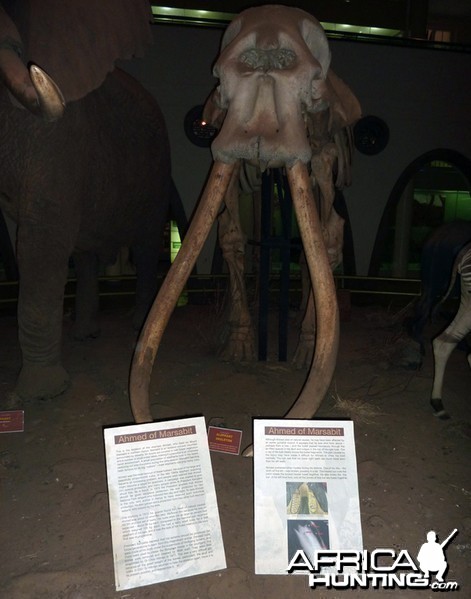
Ahmed the Elephant, Nairobi National Museum, Kenya
The Magnificent SEVEN
Dzombo (c. 1935-1983)
Origin of Name: Named after the Dzombo stream that traverses the Mopani Flats between the Shingwedzi and Shawu valleys. (The word Dzombo is derived from the Tsonga word Dzombolo meaning ‘to wait for something that is slow in coming’)
Range: He lived in the area bounded by the Tsendze, Letaba and the Shingwedzi Rivers and was most frequently seen along the grassy vlei system of the Shawu valley.
Special Features: Dzombo’s tusks are the classic shape of the Kruger National Park Elephants, bowed and curved pointing forward and slightly upwards. They were also almost identically shaped in length, weight and thickness.
General: Dzombo was the only one of the “Magnificent Seven” to be killed by poachers and it was only by a stroke of luck that Dzombo’s two tusks were not taken. He died in a hail of bullets from an AK 47 fired by a poacher from Mozambique in October 1985. The miscreants were in the act of chopping out the tusks when they were disturbed by the approach of Ranger Ampie Espag and fled leaving their trophies behind. Dzombo met an untimely death at the age of 50 years. Dzombo’s tusks are on display in the Letaba Elephant Hall.
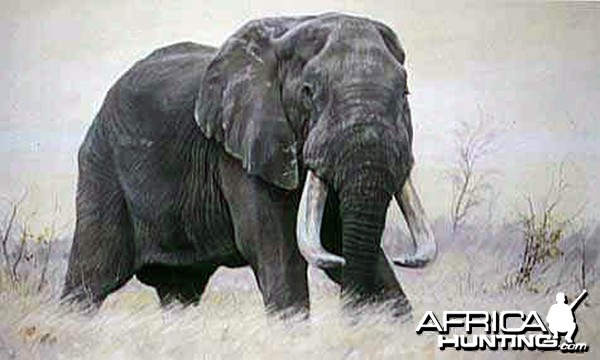
Painting of Dzombo by Wildile Artist Paul Bosman
Tusk Data:
Length : Left 237 cm (255 cm) - Right 237 cm (237 cm)
Mass : Left 56.8 kg (55.5 kg) - Right 56.8 kg
Circumference at Lip: Left 50 cm - Right 51 cm
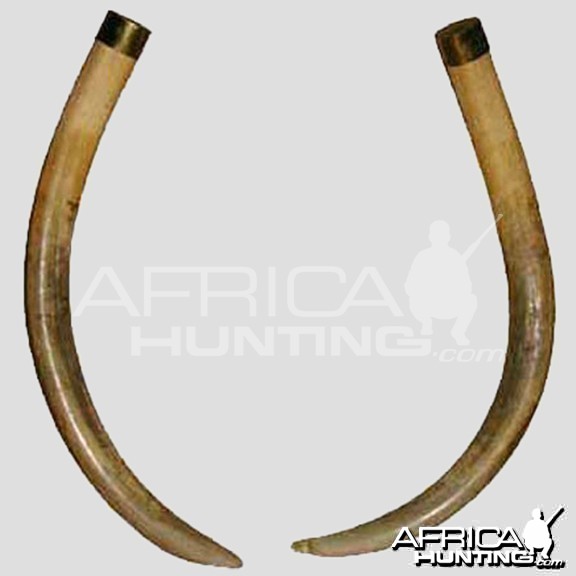
Dzombo Tusks
Joao (date unknown)
Origin of Name: Named by Anthony-Hall Martin for Prester John, legendary priest-king of ancient Africa. (Joao being the Portuguese for ‘John’) Joao was also to be found near the waterhole of this name along the Shingwedzi River. This waterhole was named in 1961 by Dr Tol Pienaar (former Warden of KNP and CEO of SANParks) after a former mechanic from Shingwedzi who assisted Dr Pienaar with fish surveys along the Shingwedzi River.
Range: Joao was first seen near a windmill called João, in the Shingwedzi region, he was known to frequent the area south of the Shingwedzi River. There were times however that he moved as far south as Mahlangene and Shilowa (East Mopani).
Special Features: Joao was a very large bull, with a shoulder height of 340cm.
General: Joao was wounded by poachers in 1982, at this time he was immobilized to investigate the damage. Fortunately the wounds were not fatal, and after a dose of antibiotics and cleaning of the wounds he was revived. While immobilized he was fitted with a radio collar and measurements of his tusks taken, he tusks were an estimated combined 130kg which at the time would have made him the heaviest ivory carrier of the Magnificent Seven. In 1984 (approximate age, 45 years) Joao broke both tusks close to the lip line (20-30cm), presumably in a fight with another bull. Unfortunately the pieces were never found and as a result Joao is the only member of the Magnificent Seven who is not represented in the Letaba Elephant Hall.
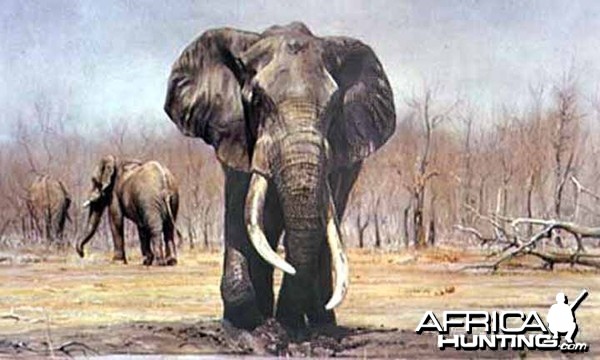
Painting of Joao by Wildile Artist Paul Bosman
Tusk Data:
Length: Left 271 cm - Right 250 cm
Mass: Left 70.0 kg - Right 60.0 kg
Circumference at Lip: Left 51 cm (55 cm) - Right 51 cm (55 cm)
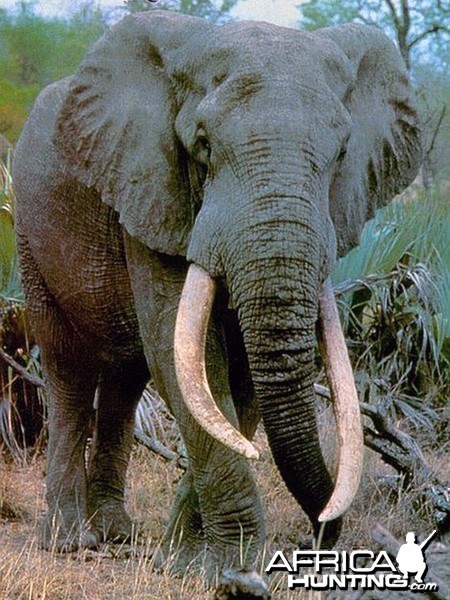
Joao Tusks
Kambaku (c. 1930-1985)
Origin of Name: Kambaku is the Tsonga word for ‘Great Tusker’ or ‘Old Elephant Bull’.
Range: This bull moved over a huge tract of country stretching from Satara/Orpen and the Timbavati to Crocodile Bridge.
Special Features: Kambaku’s left ear had a perfectly round hole in it close to the outer edge, and towards the end of his life he had no tail hairs. He was also recognized by the prominent markings on his trunk, which had the appearance of a round patch of smooth skin.
General: Kambaku was the third member of the Magnificent Seven. He was commonly seen by the rangers of the Kingfisherspruit area and was photographed by many visitors to the Kruger National Park. Uniquely unlike several of the other Magnificent Seven bull, Kambaku was always seen alone. He was more than 55-years-old when he was shot in late 1985 by Regional Ranger Lynn van Rooyen from the Lower Sabie Ranger Section. The bull was in obvious pain from a bullet wound suffered during a foray across the Crocodile River into a neighboring sugar cane fields. The bullet penetrated his left shoulder, leaving a large wound which eventually became septic. When he could not longer walk and it was clear that death was imminent, he was mercifully shot. Kambaku’s tusks are on display in the Letaba Elephant Hall.
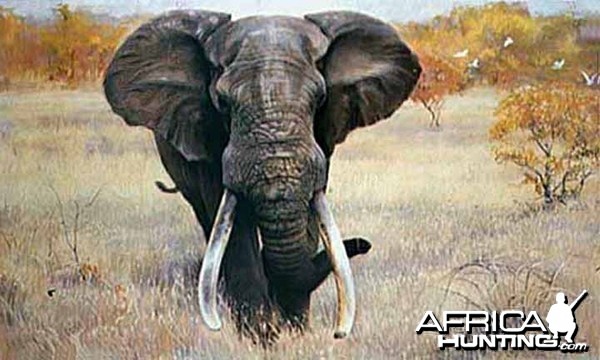
Painting of Kambaku by Wildile Artist Paul Bosman
Tusk Data:
Length: Left 259 cm - Right 265 cm
Mass: Left 63.2 kg - Right 64.0 kg
Circumference at Lip: Left 51 cm - Right 52 cm

Kambaku Tusks
Mafunyane (carcass discovered November 16, 1983)
Origin of Name: This bull was named after former warden of the Kruger National Park Lou Steyn who was well known for his quick temper. (Mafunyane is the Tsonga word for ‘the irritable one’ which appropriately refers to the elephant’s disdain for, and intolerance of humans.)
(Kloppers & Bornman (2005) (A Dictionary of KNP Place Names) gives the meaning of the name as “One who eats greedily”)
Range: This bull roamed in the Shangoni section of the Kruger National Park, which includes the upper reaches of the Shingwedzi River and southwards up to the Bububu stream.
Special Features: Mafunyane’s tusks are fairly straight and their tips are worn to a chisel-edge by as a result of being rubbed on the ground as he moved. His tusks were perfectly symmetrical and of identical length and mass. The bull had a 10cm hole in the right side of his skull that extended into his nasal cavity allowing him to breathe through this passage. One of his toes on his left hind foot was splayed to one side so that he left a distinctive impression, distinguishable from other elephants.
General: Mafunyane was the most famous of the “Magnificent Seven” although he was only seen in the wild by a handful of people, and was rarely seen by visitors as he kept well away from roads. This could be attributed to his shyness or to the fact that he chosen roaming area was very remote. Mafunyane despite having impressive tusks, was not a large bull and was only 327cm at the shoulder, when compared with the average 340cm shoulder height of the other members of the Magnificent Seven. The immobilization of Mafunyane on the 8 June 1983 to fit a radio collar and to make plaster cases of the bull’s ivory nearly spelled the end for this bull. When given the antidote to the immobilization drugs Mafunyane due to his immense tusk size was unable to ‘rock’ himself onto his chest which would have allowed him to stand up, and his repeated efforts caused him to dig his tusks further into the ground. Several strategies were tried to raise him but all failed. After he had been down for several hours and front end loader was brought into assist the team. Mafunyane was eventually ‘scooped’ to his feet and the bull rose and ran into the nearby Mopane bushes much to the relief of the capture team. Mafunyane’s remains were found on 16 November 1983 near Tari River, Northwest of Shingwedzi. He had been dead for approximately 3-4weeks and appeared to have died of natural causes. He was about 57 years old when he died. Mafunyane’s tusks are on display in the Letaba Elephant Hall.
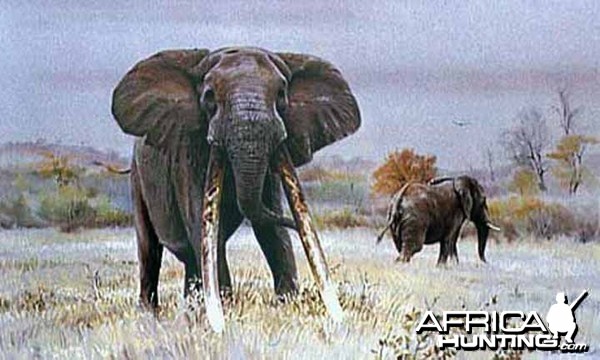
Painting of Mafunyane by Wildile Artist Paul Bosman
Tusk Data:
Length: Left 251 cm - Right 251 cm
Mass: Left 55.1 kg - Right 55.1 kg
Circumference at Lip: Left 48 cm - Right 48 cm
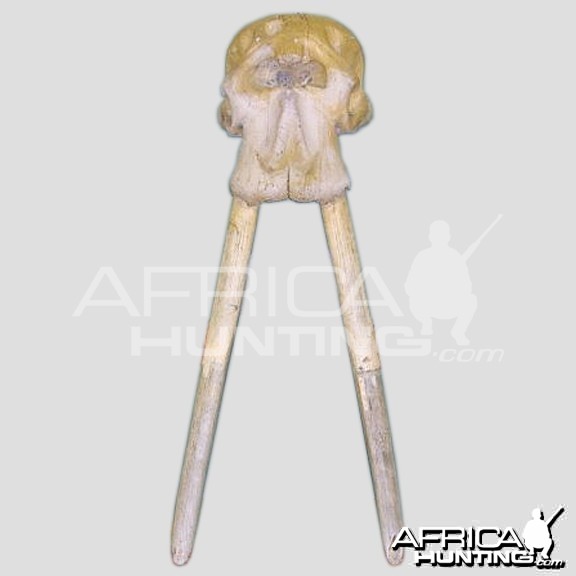
Mafunyane Tusks
Ndlulamithi (c. 1927-1985)
Origin of Name: Ndlulamithi earned his name from his appearance, which is a traditional Tsonga word meaning “taller than the trees”.
Range: His range was known to occupy a large area between the main road from Mooiplaas to the western boundary and stretching from Byashishi drainage system across to Shingwedzi River to the Phongol River.
Special Features: The handsomely curved tusks of Ndlulamithi, the left one sweeping low and well forward, are significantly more twisted than those of the other large bulls. He was considered a tall Elephant probably around 340 – 345cm high at the shoulder.
General: Ndulamithi was first identified in 1980 along the Nkokodzi River in northern Kruger National Park. He was an aggressive yet secretive elephant, and was seldom seen. This bull received some fame for charging Dr Anthony Hall-Martin and his assistant while they were trying to photograph him on foot, his intentions unmistakable. He died of natural causes in 1985 in the Shangoni area at an estimated 58 years of age. Paul Zway section ranger of Shangoni at the time found his remains not far from the Nkokodzi Spruit. Ndulamithi’s tusks are on display in the Letaba Elephant Hall.
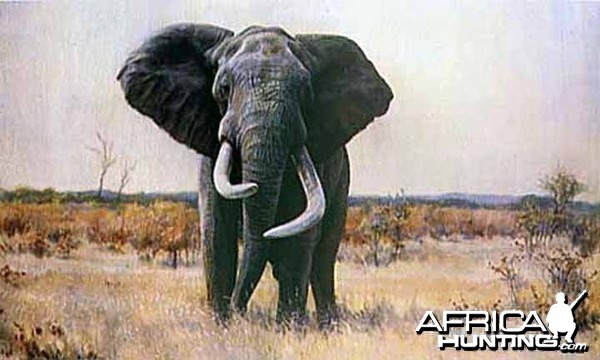
Painting of Ndlulamithi by Wildile Artist Paul Bosman
Tusk Data:
Length: Left 287 cm - Right 273 cm
Mass: Left 64.6 kg - Right 57.2 kg
Circumference at Lip: Left 48.8 cm (48.8 cm) - Right 48 cm

Ndlulamithi Tusks
Shawu (October 1982)
Origin of Name: The “Shawu Bull” was named after the Shawu valley (Vlei) in which he spent much of his life.
Range: Shawu moved over a large range which spanned the flat Mopani covered plains country between the Letaba and Shingwedzi rivers and stretched from the main road to Lebombo Hills. He did not however, cover this enormous area regularly, but drifted around slowly, taking about 6 months to move from South to North.
Special Features: Shawu’s tusks are the longest on record in the Kruger National Park and one of the 6th longest to ever come out of Africa.
General: Shawu was a fairly approachable animal and showed no particular fear or distrust of vehicles. He was a large bull having a shoulder height of 340cm. Due to the pincer formed by his large tusks he was sometimes referred to in Afrikaans as “Groot Haaktand”. In 1981 it was decided to fit Shawu with a collar as poaching was a constant threat from Mozambique, this was successfully and he was monitored on a regular basis. Shawu died of old age in the Kostini area east of Shingwedzi, near the northern watershed of the Shawu Valley (Vlei) in October 1982. He had been ill for some time and his condition and movements were monitored daily towards the end of his life by means of a radio transmitter which had been fitted in a collar around his neck. He was close to 60 years old when he died. Shawu’s tusks are on display in the Letaba Elephant Hall.
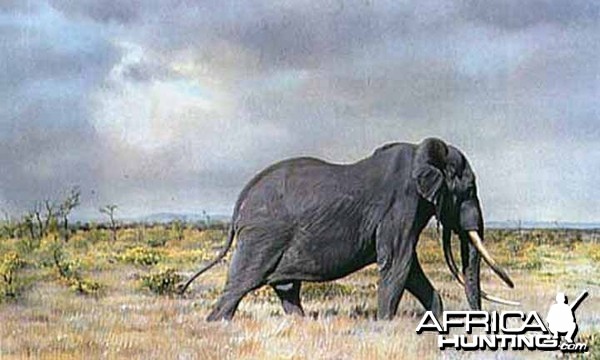
Painting of Shawu by Wildile Artist Paul Bosman
Tusk Data:
Length: Left 3171 cm - Right 305 cm (305.5 cm)
Mass: Left 52.6 kg (52.7 kg) - Right 50.8 kg
Circumference at Lip: Left 45 cm - Right 45 cm
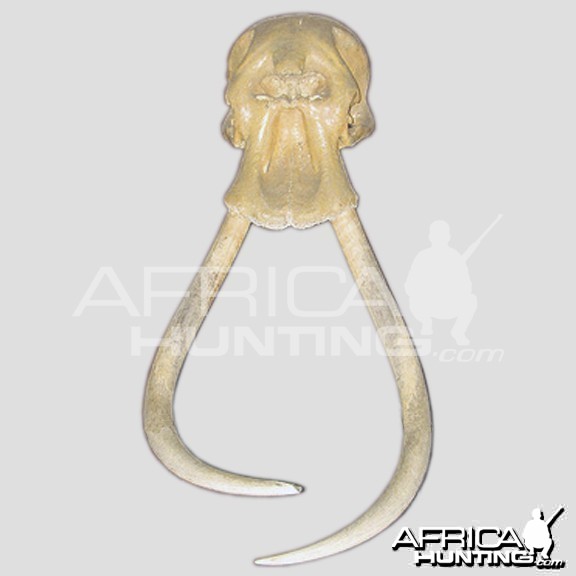
Shawu Tusks
Shingwedzi (c. 1934-1981)
Origin of Name: Shingwedzi was named after the river and rest camp where he spent the last few years of his life. (Shingwedzi means, “place of ironstone” referring to the gabbro rock outcrops common to the area. Shingwedzi is derived from the Tsonga word Ngwetse which means ‘the sound of metal objects rubbing against each other’).
Range: Shingwedzi was known to move as far west as Nkokodzi and Chugamila hills and as far as the Lebombo’s in the vicinity of Shingwedzi Rest Camp.
Special Features: Shingwedzi’s ivory offers a good example of the classic master servant tusks. He had a large right servant tusk and a shorter left master tusk.
General: Shingwedzi was found dead under a Sycamore Fig and short distance from Shingwedzi camp in January 1981, and as far as can be determine he died of natural causes. The age of an Elephant can be fairly accurately determined from the state of wear of the teeth. In the case of Shingwedzi the last molar (molar 6) was well worn down, giving him an estimated age of 65 (56) years. Shingwedzi’s tusks are on display in the Letaba Elephant Hall.
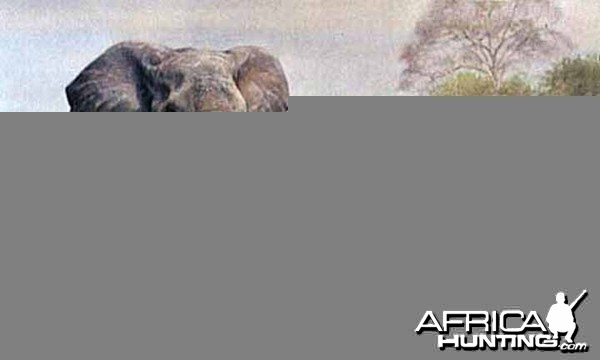
Painting of Shingwedzi by Wildile Artist Paul Bosman
Tusk Data:
Length: Left 207 cm - Right 264 cm
Mass: Left 47.2 kg - Right 58.1 kg
Circumference at Lip: Left 47.5 cm - Right 48 cm
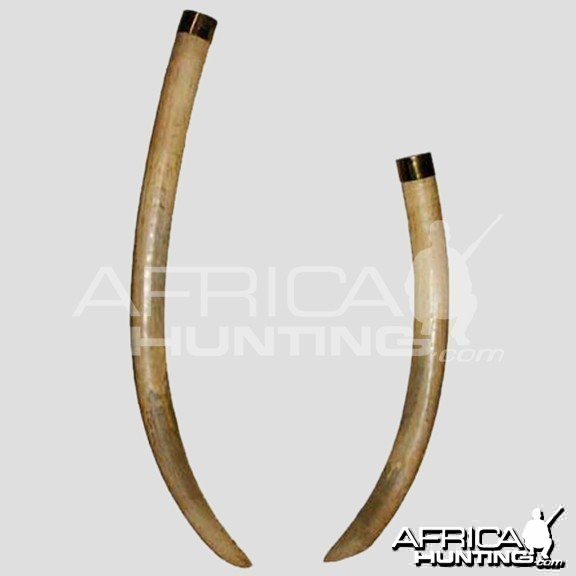
Shingwedzi Tusks
Elephant Head Mount at Letaba Elephant Hall, Kruger National Park
Letaba Elephant Hall at Kruger National Park is home of the Magnificent Seven. Over thirty years ago seven impressive elephant bulls, all with tusks weighing more than 50 kg each, could be found in Kruger National Park. The Chief Warden at the time, Dr. U de V Pienaar, decided to publicise these elephants as a successful example of Kruger's conservation work. He named those bulls that had not already been identified and also coined the collective name, the Magnificent Seven, based on the 1960 Hollywood film.
The Letaba Elephant Hall at Kruger National Park, South Africa displays most of the Magnificent Seven skulls, the great tuskers of Kruger. The skull in the foreground was found in the park as is, with a tusk embedded in it.
The promotion was launched in 1980 with specially commissioned paintings by celebrated wildlife artist Paul Bosman and illustrated articles written by the park's Senior Research Officer, Dr. Anthony Hall-Martin.
The public reaction was staggering and, when each of these great elephants died, it was decided to retrieve their tusks and skulls in order to display them. The Elephant Hall at Letaba Rest Camp now holds the tusks of Dzombo, Kambaku, Mafunyane, Ndlulamithi, Shawu and Shingwedzi.
The age of each of these elephants was estimated. Many marvellous stories are told about the size of these great mammals growing up to a height of 12 feet (nearly 3.7 meters) with a mass of 13,000 lb (6.000 kg) and tusks weighing in excess of 200 lb (91 kg) and reaching a length of 11 feet ( 3.35 meters).
The largest set of tusks currently available are a pair kept in the British Museum of Natural History weighing 226.25 lb and 214 lb a side, originating from the Legamishura crater. Another pair in the American Museum of Natural history weighing 189 lb and 178 lb a side originating from Kenya. Another pair came from an Elephant shot by the hunter: Maj. Powell-Cotton near Lake Albert in Uganda in the 1880’s, weighing 198 lb and 174 lb a side. A pair weighing 192 lb and 189 lb a side was shot in Tanzania in 1971. The hunter Harry Manners shot an Elephant with a set of tusks weighing 185 lb and 183 lb a side on the Malawi border. The famous hunter in Africa Frederick Courteney Selous mentioned that the largest tusk known coming from Botswana came from the Ngami Lake area; weighing 179 lb and many more stories are told about massive tuskers.
The longest set of tusks known belonged to an Elephant shot by Maj. Powel-Cotton measuring 11ft 5in and 11 ft ( 3.48 and 3.35 m ) respectively.
A legendary tusker was Ahmed roaming the plains of Marsabit in Kenya, who was proclaimed a National Monument and had a game guide assigned to looking after him. Ahmed’s tusks were recovered after he had died, a perfect matched pair weighing 148 lb a side.
Ahmed the Elephant, Nairobi National Museum, Kenya
Ahmed the Elephant, Nairobi National Museum, Kenya
The Magnificent SEVEN
Dzombo (c. 1935-1983)
Origin of Name: Named after the Dzombo stream that traverses the Mopani Flats between the Shingwedzi and Shawu valleys. (The word Dzombo is derived from the Tsonga word Dzombolo meaning ‘to wait for something that is slow in coming’)
Range: He lived in the area bounded by the Tsendze, Letaba and the Shingwedzi Rivers and was most frequently seen along the grassy vlei system of the Shawu valley.
Special Features: Dzombo’s tusks are the classic shape of the Kruger National Park Elephants, bowed and curved pointing forward and slightly upwards. They were also almost identically shaped in length, weight and thickness.
General: Dzombo was the only one of the “Magnificent Seven” to be killed by poachers and it was only by a stroke of luck that Dzombo’s two tusks were not taken. He died in a hail of bullets from an AK 47 fired by a poacher from Mozambique in October 1985. The miscreants were in the act of chopping out the tusks when they were disturbed by the approach of Ranger Ampie Espag and fled leaving their trophies behind. Dzombo met an untimely death at the age of 50 years. Dzombo’s tusks are on display in the Letaba Elephant Hall.
Painting of Dzombo by Wildile Artist Paul Bosman
Tusk Data:
Length : Left 237 cm (255 cm) - Right 237 cm (237 cm)
Mass : Left 56.8 kg (55.5 kg) - Right 56.8 kg
Circumference at Lip: Left 50 cm - Right 51 cm
Dzombo Tusks
Joao (date unknown)
Origin of Name: Named by Anthony-Hall Martin for Prester John, legendary priest-king of ancient Africa. (Joao being the Portuguese for ‘John’) Joao was also to be found near the waterhole of this name along the Shingwedzi River. This waterhole was named in 1961 by Dr Tol Pienaar (former Warden of KNP and CEO of SANParks) after a former mechanic from Shingwedzi who assisted Dr Pienaar with fish surveys along the Shingwedzi River.
Range: Joao was first seen near a windmill called João, in the Shingwedzi region, he was known to frequent the area south of the Shingwedzi River. There were times however that he moved as far south as Mahlangene and Shilowa (East Mopani).
Special Features: Joao was a very large bull, with a shoulder height of 340cm.
General: Joao was wounded by poachers in 1982, at this time he was immobilized to investigate the damage. Fortunately the wounds were not fatal, and after a dose of antibiotics and cleaning of the wounds he was revived. While immobilized he was fitted with a radio collar and measurements of his tusks taken, he tusks were an estimated combined 130kg which at the time would have made him the heaviest ivory carrier of the Magnificent Seven. In 1984 (approximate age, 45 years) Joao broke both tusks close to the lip line (20-30cm), presumably in a fight with another bull. Unfortunately the pieces were never found and as a result Joao is the only member of the Magnificent Seven who is not represented in the Letaba Elephant Hall.
Painting of Joao by Wildile Artist Paul Bosman
Tusk Data:
Length: Left 271 cm - Right 250 cm
Mass: Left 70.0 kg - Right 60.0 kg
Circumference at Lip: Left 51 cm (55 cm) - Right 51 cm (55 cm)
Joao Tusks
Kambaku (c. 1930-1985)
Origin of Name: Kambaku is the Tsonga word for ‘Great Tusker’ or ‘Old Elephant Bull’.
Range: This bull moved over a huge tract of country stretching from Satara/Orpen and the Timbavati to Crocodile Bridge.
Special Features: Kambaku’s left ear had a perfectly round hole in it close to the outer edge, and towards the end of his life he had no tail hairs. He was also recognized by the prominent markings on his trunk, which had the appearance of a round patch of smooth skin.
General: Kambaku was the third member of the Magnificent Seven. He was commonly seen by the rangers of the Kingfisherspruit area and was photographed by many visitors to the Kruger National Park. Uniquely unlike several of the other Magnificent Seven bull, Kambaku was always seen alone. He was more than 55-years-old when he was shot in late 1985 by Regional Ranger Lynn van Rooyen from the Lower Sabie Ranger Section. The bull was in obvious pain from a bullet wound suffered during a foray across the Crocodile River into a neighboring sugar cane fields. The bullet penetrated his left shoulder, leaving a large wound which eventually became septic. When he could not longer walk and it was clear that death was imminent, he was mercifully shot. Kambaku’s tusks are on display in the Letaba Elephant Hall.
Painting of Kambaku by Wildile Artist Paul Bosman
Tusk Data:
Length: Left 259 cm - Right 265 cm
Mass: Left 63.2 kg - Right 64.0 kg
Circumference at Lip: Left 51 cm - Right 52 cm
Kambaku Tusks
Mafunyane (carcass discovered November 16, 1983)
Origin of Name: This bull was named after former warden of the Kruger National Park Lou Steyn who was well known for his quick temper. (Mafunyane is the Tsonga word for ‘the irritable one’ which appropriately refers to the elephant’s disdain for, and intolerance of humans.)
(Kloppers & Bornman (2005) (A Dictionary of KNP Place Names) gives the meaning of the name as “One who eats greedily”)
Range: This bull roamed in the Shangoni section of the Kruger National Park, which includes the upper reaches of the Shingwedzi River and southwards up to the Bububu stream.
Special Features: Mafunyane’s tusks are fairly straight and their tips are worn to a chisel-edge by as a result of being rubbed on the ground as he moved. His tusks were perfectly symmetrical and of identical length and mass. The bull had a 10cm hole in the right side of his skull that extended into his nasal cavity allowing him to breathe through this passage. One of his toes on his left hind foot was splayed to one side so that he left a distinctive impression, distinguishable from other elephants.
General: Mafunyane was the most famous of the “Magnificent Seven” although he was only seen in the wild by a handful of people, and was rarely seen by visitors as he kept well away from roads. This could be attributed to his shyness or to the fact that he chosen roaming area was very remote. Mafunyane despite having impressive tusks, was not a large bull and was only 327cm at the shoulder, when compared with the average 340cm shoulder height of the other members of the Magnificent Seven. The immobilization of Mafunyane on the 8 June 1983 to fit a radio collar and to make plaster cases of the bull’s ivory nearly spelled the end for this bull. When given the antidote to the immobilization drugs Mafunyane due to his immense tusk size was unable to ‘rock’ himself onto his chest which would have allowed him to stand up, and his repeated efforts caused him to dig his tusks further into the ground. Several strategies were tried to raise him but all failed. After he had been down for several hours and front end loader was brought into assist the team. Mafunyane was eventually ‘scooped’ to his feet and the bull rose and ran into the nearby Mopane bushes much to the relief of the capture team. Mafunyane’s remains were found on 16 November 1983 near Tari River, Northwest of Shingwedzi. He had been dead for approximately 3-4weeks and appeared to have died of natural causes. He was about 57 years old when he died. Mafunyane’s tusks are on display in the Letaba Elephant Hall.
Painting of Mafunyane by Wildile Artist Paul Bosman
Tusk Data:
Length: Left 251 cm - Right 251 cm
Mass: Left 55.1 kg - Right 55.1 kg
Circumference at Lip: Left 48 cm - Right 48 cm
Mafunyane Tusks
Ndlulamithi (c. 1927-1985)
Origin of Name: Ndlulamithi earned his name from his appearance, which is a traditional Tsonga word meaning “taller than the trees”.
Range: His range was known to occupy a large area between the main road from Mooiplaas to the western boundary and stretching from Byashishi drainage system across to Shingwedzi River to the Phongol River.
Special Features: The handsomely curved tusks of Ndlulamithi, the left one sweeping low and well forward, are significantly more twisted than those of the other large bulls. He was considered a tall Elephant probably around 340 – 345cm high at the shoulder.
General: Ndulamithi was first identified in 1980 along the Nkokodzi River in northern Kruger National Park. He was an aggressive yet secretive elephant, and was seldom seen. This bull received some fame for charging Dr Anthony Hall-Martin and his assistant while they were trying to photograph him on foot, his intentions unmistakable. He died of natural causes in 1985 in the Shangoni area at an estimated 58 years of age. Paul Zway section ranger of Shangoni at the time found his remains not far from the Nkokodzi Spruit. Ndulamithi’s tusks are on display in the Letaba Elephant Hall.
Painting of Ndlulamithi by Wildile Artist Paul Bosman
Tusk Data:
Length: Left 287 cm - Right 273 cm
Mass: Left 64.6 kg - Right 57.2 kg
Circumference at Lip: Left 48.8 cm (48.8 cm) - Right 48 cm
Ndlulamithi Tusks
Shawu (October 1982)
Origin of Name: The “Shawu Bull” was named after the Shawu valley (Vlei) in which he spent much of his life.
Range: Shawu moved over a large range which spanned the flat Mopani covered plains country between the Letaba and Shingwedzi rivers and stretched from the main road to Lebombo Hills. He did not however, cover this enormous area regularly, but drifted around slowly, taking about 6 months to move from South to North.
Special Features: Shawu’s tusks are the longest on record in the Kruger National Park and one of the 6th longest to ever come out of Africa.
General: Shawu was a fairly approachable animal and showed no particular fear or distrust of vehicles. He was a large bull having a shoulder height of 340cm. Due to the pincer formed by his large tusks he was sometimes referred to in Afrikaans as “Groot Haaktand”. In 1981 it was decided to fit Shawu with a collar as poaching was a constant threat from Mozambique, this was successfully and he was monitored on a regular basis. Shawu died of old age in the Kostini area east of Shingwedzi, near the northern watershed of the Shawu Valley (Vlei) in October 1982. He had been ill for some time and his condition and movements were monitored daily towards the end of his life by means of a radio transmitter which had been fitted in a collar around his neck. He was close to 60 years old when he died. Shawu’s tusks are on display in the Letaba Elephant Hall.
Painting of Shawu by Wildile Artist Paul Bosman
Tusk Data:
Length: Left 3171 cm - Right 305 cm (305.5 cm)
Mass: Left 52.6 kg (52.7 kg) - Right 50.8 kg
Circumference at Lip: Left 45 cm - Right 45 cm
Shawu Tusks
Shingwedzi (c. 1934-1981)
Origin of Name: Shingwedzi was named after the river and rest camp where he spent the last few years of his life. (Shingwedzi means, “place of ironstone” referring to the gabbro rock outcrops common to the area. Shingwedzi is derived from the Tsonga word Ngwetse which means ‘the sound of metal objects rubbing against each other’).
Range: Shingwedzi was known to move as far west as Nkokodzi and Chugamila hills and as far as the Lebombo’s in the vicinity of Shingwedzi Rest Camp.
Special Features: Shingwedzi’s ivory offers a good example of the classic master servant tusks. He had a large right servant tusk and a shorter left master tusk.
General: Shingwedzi was found dead under a Sycamore Fig and short distance from Shingwedzi camp in January 1981, and as far as can be determine he died of natural causes. The age of an Elephant can be fairly accurately determined from the state of wear of the teeth. In the case of Shingwedzi the last molar (molar 6) was well worn down, giving him an estimated age of 65 (56) years. Shingwedzi’s tusks are on display in the Letaba Elephant Hall.
Painting of Shingwedzi by Wildile Artist Paul Bosman
Tusk Data:
Length: Left 207 cm - Right 264 cm
Mass: Left 47.2 kg - Right 58.1 kg
Circumference at Lip: Left 47.5 cm - Right 48 cm
Shingwedzi Tusks
Last edited by a moderator:


